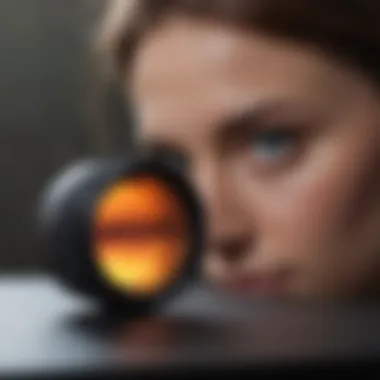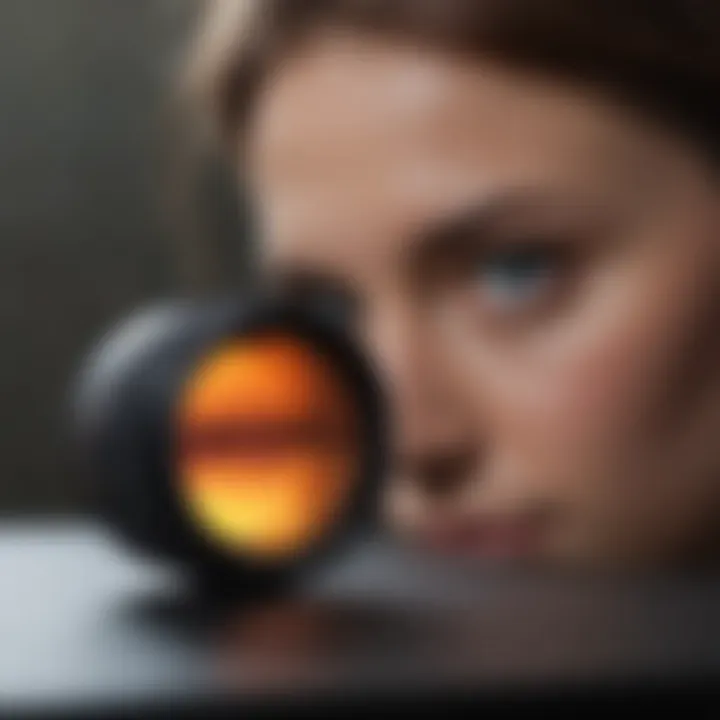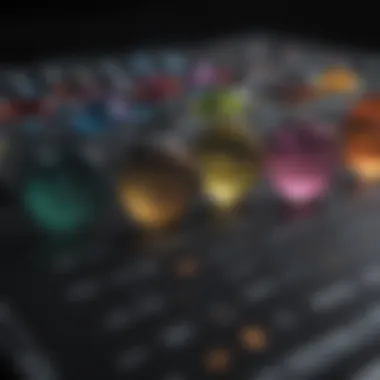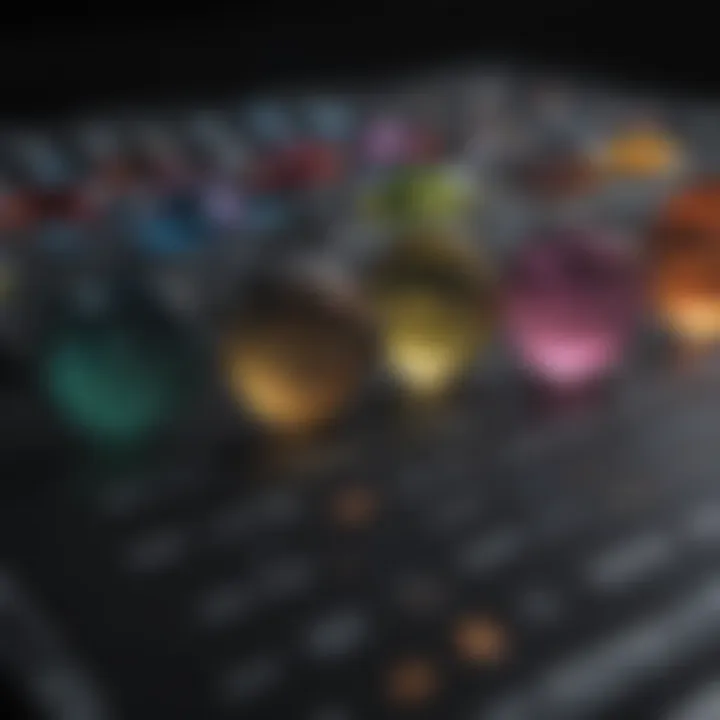Understanding the Financial Aspects of Color Blindness Glasses


Intro
Color blindness may seem like a minor issue at first glance, yet for those who experience it, it can profoundly affect daily life. From misidentifying colors in traffic signals to problems distinguishing hues on a canvas, the challenges are real. As such, there has been increasing interest in various technologies that seek to alleviate these difficulties. Among these solutions, color blindness correction glasses stand out as a promising option. However, their cost, often exorbitant, raises questions for many consumers. This brings us to the exploration of the economic considerations surrounding these specialized lenses.
In this article, we will unravel the intricacies of the costs tied to color blindness correction glasses. We will examine multiple factors that influence these prices, including advancements in technology, variations in lens quality, and market dynamics. Additionally, we'll assess the potential coverage options from insurance policies, shedding light on how they can impact the financial burden. By the end of this comprehensive guide, readers will gain a deeper understanding of the financial implications as well as the broader context of color blindness correction technology.
Article Overview
Purpose of the Article
The aim here isn't just to throw a bunch of numbers around; instead, we want to provide a full picture of what one might expect when looking into purchasing these glasses. We’ll touch on everything from the basics of color blindness and corrective lenses to the various pricing structures one might encounter. Understanding the cost can often be the first step toward making informed decisions about one's eye health.
Relevance to Multiple Disciplines
The financial implications of color blindness correction glasses transcend individual interest. They stretch into the realms of healthcare, education, and occupational safety. For instance, educators and employers might find new ways to assist individuals affected by color blindness to better equip them in their educational and professional pursuits. Furthermore, advancements in optical technology are a hot topic in research sectors concerned with vision science and healthcare economics.
Research Background
Historical Context
To truly grasp the cost of color blindness correction glasses, it’s vital to look back and understand the history leading up to their current development. Originally, color blindness was seen mainly as a hereditary issue with limited solutions. However, with the rise of optical technologies in the late 20th century, various methods aimed at correcting or compensating for color vision deficiency began to emerge. These innovations paved the way for what we have today—glasses designed not only to filter light but also to enhance color perception.
Key Concepts and Definitions
First, let’s break down a few terminologies to set the stage. Color blindness, or color vision deficiency, refers to the inability to perceive colors in a typical way. The types of color blindness vary, with the most common being red-green color blindness.
As for the glasses, many of them utilize special coatings and filters that manipulate light wavelengths, allowing users to distinguish colors that would otherwise blend into one another. This technology can differ significantly, impacting the price one pays for a pair of corrective lenses.
In summary, by examining historical data, key terminologies, and the financial landscape, we set ourselves up for a more nuanced understanding of the costs associated with color blindness correction glasses. Embracing this knowledge can help power well-informed discussions and decisions as we delve further into this topic.
Intro to Color Blindness
Color blindness, although often thought of as a simple visual deficiency, is a layered condition that affects countless individuals around the world. Understanding how it impacts day-to-day activities, social interactions, and even professional environments can open avenues for better solutions and aids, particularly color blindness correction glasses. Recognizing the costs associated with these corrective eyewear options is crucial.
The significance of delving into this subject is twofold—first, it aids those affected by color blindness in identifying potential solutions that can substantially improve their quality of life. Second, it provides insights for optometrists and manufacturers to craft offerings that not only meet visual needs but also align economically with various consumers.
In this section, we will explore the very definition of color blindness. This includes discussing its prevalence around the globe and the types of color vision deficiencies prevalent within the population. With this foundational understanding, readers will be well-prepared to comprehend how corrective glasses can serve those living with this condition.
Defining Color Blindness
Color blindness, also known as color vision deficiency, refers to the inability to perceive colors in a typical manner. It's not a complete inability to see color, but rather a profound difficulty distinguishing between specific shades. This condition commonly arises from genetic factors, usually linked to the X chromosome. Men are more often affected than women, with approximately 8% of males and only about 0.5% of females having some form of color blindness.
People with color vision deficiencies may find themselves seeing only shades of gray, or they may confuse certain colors, particularly reds and greens or blues and yellows. For instance, someone with red-green color blindness may not be able to differentiate between a ripe tomato and foliage, leading to frustration in daily situations.
Prevalence and Types of Color Blindness
Understanding the prevalence and the specific types of color blindness sheds light on the complexities surrounding the condition. Some key points to consider:
- Overall Impact: It's estimated that approximately 1 in 12 men and 1 in 200 women have some form of color blindness. This staggering statistic emphasizes the widespread nature of the issue.
- Common Types:


- Red-Green Color Blindness: The most prevalent form, often involving difficulty distinguishing between red and green shades. This is commonly found in those affected by protanopia or deuteranopia.
- Blue-Yellow Color Blindness: Less common than red-green deficiencies, this category includes tritanopia, where individuals struggle to differentiate between blue and yellow colors.
- Monochromacy: A rare condition where individuals see only shades of gray, significantly impacting their color perception.
"Color blindness isn’t just a minor inconvenience; it can alter how people interact with the world, both personally and professionally."
"Color blindness isn’t just a minor inconvenience; it can alter how people interact with the world, both personally and professionally."
Awareness around these factors is essential, as it lays the groundwork for understanding how color blindness correction glasses can assist individuals. Each type presents unique challenges, all of which deserve exploration in later discussions regarding corrective solutions.
Understanding Corrective Glasses
Understanding corrective glasses for color blindness is a vital aspect of addressing the needs of individuals affected by this condition. These specialized lenses do more than just improve visual clarity; they transform the way colorblind users perceive the world around them. By separating specific wavelengths of light, these glasses allow people to distinguish between colors that might otherwise be indistinguishable, which can have profound implications for daily life and personal fulfillment.
Through this section, we will explore how these glasses function and what types of technologies exist. One of the main benefits of understanding corrective glasses is that users can make informed choices about which products might work best based on their specific type of color blindness. Equally important, comprehension of these devices helps patients realize the limitations and expectations that should guide their use.
In a world where color can influence mood, culture, and communication, how colorblind individuals adapt or struggle without effective corrective solutions is a conversation worth having. People might wonder about their options, leading to critical questions about cost versus effectiveness, how technology varies, and which glasses are worth the investment.
How Do Color Correction Glasses Work?
Color correction glasses work by filtering light to enhance certain colors while dampening others. The lenses are usually tinted or utilize coatings designed to modify the wavelengths that reach the retina.
For instance, take a person who has red-green color blindness. In their case, these lenses filter out some of the wavelengths that create the confusion between reds and greens, permitting clearer distinction and interpretation of those colors. This adjustment can lead to a more vibrant visual experience.
Essentially, the operation of these glasses boils down to manipulating light, thereby reshaping the visual signals sent to the brain. However, it's noteworthy that the effectiveness of these lenses can vary depending on the severity of an individual's color vision deficiency.
Different Technologies Used in Color Blindness Glasses
The technologies available for color blindness correction have seen a range of developments in recent years. Here’s a more in-depth look:
- Specialized Tints: Many colorblind glasses rely on specific tints that enhance color perception for particular types of color blindness. For instance, lenses from brands like EnChroma specifically cater to red-green deficiencies.
- Nanotechnology: Some new-age glasses utilize nanotechnology to fine-tune how light interacts with the lens material. This tech offers a more tailored solution for individuals facing color discrimination in their everyday life.
- Digital Devices: With the rapid advancement in wearable technology, digital lenses that can modify their tint based on surrounding light conditions are also on the horizon. This innovation seeks to add more versatility to how users engage with their environment.
While these technologies vary in complexity, they all aim for one common goal: to improve the quality of life for those with color blindness. Being equipped with knowledge about these innovations not only aids potential users in selecting the right glasses but also sparks broader discussions about accessibility and inclusion in various facets of life.
Costs Associated with Color Blindness Glasses
Understanding the costs linked to color blindness correction glasses is essential for anyone considering their use. These expenses can vary widely due to numerous factors, making it necessary to approach the topic with a discerning eye. The financial aspect doesn't merely reflect the price of the glasses; it encompasses the technology involved, potential long-term benefits, and accessibility considerations. By acknowledging the importance of these costs, individuals can make informed decisions that balance quality, efficacy, and budget constraints.
Factors Influencing Pricing
When it comes to pricing, there’s more than meets the eye. Several factors play a key role in determining how much one should expect to spend on color blindness glasses:
- Technology: The type of technology used in the lenses significantly impacts costs. Advances in optical science may come with a premium price but can offer much-needed clarity.
- Lens Quality: Higher quality materials can elevate pricing but also enhance durability and comfort over time. Specialty coatings or customized prescriptions naturally climb the pricing scale.
- Brand Reputation: Established brands like EnChroma or Pilestone often charge more, banking on their hallowed reputations and proven track records.
- Retail Markup: Where you buy, whether it’s an online store or a local optical shop, can also affect your final bill. Brick-and-mortar establishments usually have higher overhead costs.
These factors combine to form a complex pricing structure that can confuse those new to the eyewear market. However, getting a handle on them can lead to better purchasing decisions.
Average Price Range of Color Blindness Glasses
Diving deeper into the numbers, potential buyers will find a range that can be quite staggering. On average, color blindness glasses range from about $100 to $500. This price spectrum can vary based on the influences mentioned previously:
- Low-End Options: You might find basic pairs starting around $100, often suitable for short-term use or experimentation. They are generally not as effective but are budget-friendly.
- Mid-Range Options: Expect to pay roughly $200 to $300 for glasses that offer improved technology and comfort. Many users find these to be the sweet spot, balancing quality and price.
- High-End Choices: Specialty models aimed at serious users can push costs beyond $400. These glasses often utilize the latest technology and materials, providing the best results.
Comparison of Different Brands Available


When considering various brands, it’s essential to compare what each offers. Not all glasses are created equal, and knowing the differences can save both time and money:
- EnChroma: Known for their bright designs and advanced filter technology, these glasses often come with a higher price tag but have users reporting significant satisfaction. Their lenses are particularly effective in various light conditions, making them a popular choice.
- Pilestone: Offering more affordable options, Pilestone glasses are no slouch in performance. They carry a reputation for being adaptable for different types of color blindness and come in a range of styles.
- ColorMax: A newer player in the field, ColorMax provides competitively priced glasses that may appeal to younger audiences. With a focus on stylish options, they aim to bridge affordability with effectiveness.
Carefully assessing these brands by user reviews and personal recommendations can greatly impact your choice. Investing in something that works well for your specific needs is paramount.
Remember, the best choice often aligns with individual preferences and requirements.
Remember, the best choice often aligns with individual preferences and requirements.
Ultimately, the journey to find suitable color blindness glasses is as personal as it is financial. With keen awareness of the costs involved and diligence in researching options, overcoming the challenges of color blindness may soon be within reach.
Evaluating Effectiveness
The journey of understanding color blindness correction glasses goes beyond merely assessing their cost; the effectiveness of these glasses holds paramount importance. Evaluating their effectiveness helps potential users grasp the real-world benefits and limitations, aiding informed decisions. If someone is going to invest a significant amount into a pair of glasses, knowing how they actually perform is essential. This section looks at how user experiences and scientific evidence shape our understanding of these corrective tools.
User Experiences and Testimonials
Feedback from users provides a vivid picture of what it’s like to wear color blindness correction glasses. Personal accounts unveil the transformative effects these glasses can have on daily life. For some, they disclose a vibrant world once thought unobtainable.
- Improved Color Recognition: Many users claim they can now distinguish shades that were previously indistinguishable. For example, reds and greens, often problematic for the color blind, become more apparent.
- Enhanced Daily Tasks: Simple activities, like choosing ripe fruit at the grocery store or determining matching clothing, turn into less daunting tasks. Such experiences are often portrayed as life-changing.
- Emotional Impact: There’s often an emotional aspect tied to these testimonials. Users often express joy and relief. One refrain is how the glasses allow a new level of engagement with family and friends, particularly in activities like attending concerts or sports events.
A common theme emerges: satisfaction levels vary. While some feel a marked improvement, others report only subtle changes. This variability highlights the individual physiological differences among color blind individuals. One user described it this way:
"When I put on the glasses for the first time, I was honestly blown away. It felt like someone flipped a switch in my brain, and I saw colors I had only imagined. Yet, I couldn’t help but feel a tinge of disappointment when some shades still appeared muddled."
"When I put on the glasses for the first time, I was honestly blown away. It felt like someone flipped a switch in my brain, and I saw colors I had only imagined. Yet, I couldn’t help but feel a tinge of disappointment when some shades still appeared muddled."
Despite some mixed reviews, the importance of personal testimony cannot be understated. It reflects subjective reality rather than relying solely on clinical data.
Scientific Studies on Efficacy
Scientific investigations into the efficacy of color blindness correction glasses provide a more structured examination. Various research studies have sought to quantify what users experience with these lenses.
- Visual Acuity Tests: Several studies used standardized tests to assess color discrimination improvement among users. Results often show statistical significance in color differentiation after using the glasses compared to without. This scientific backing reinforces some anecdotal evidence shared by users.
- Group Variability: Research highlights how varying degrees of color blindness, such as red-green or blue-yellow, influence the effectiveness of these glasses. Some individuals may experience considerable changes in color perception, while others may notice less impact.
- Long-term Adaptation: Some research looked into how users adapt over time. A few studies suggest that continuous use may enhance users' ability to recognize colors, not only because of the glasses but also due to an adapted cognitive process over time.
Summarizing the findings from this body of research, the effectiveness of color blindness glasses isn't a one-size-fits-all scenario. Just as in user testimonials, the outcomes cover a spectrum of experiences. They provide valuable insights, but potential wearers should keep in mind that results depend on individual conditions.
In essence, understanding the effectiveness of color blindness glasses requires a blend of personal experiences and scientific inquiry. This two-pronged approach offers a comprehensive view, ensuring future users can navigate their choices with confidence.
The Role of Insurance
Navigating the waters of acquiring color blindness correction glasses can be daunting, and insurance can play a pivotal role in easing the financial burden. Understanding how insurance interacts with these specialized eyewear options is vital for consumers who might find themselves weighing the costs against the benefits. The importance of insurance coverage cannot be overstated; it can mean the difference between affording these corrective tools or potentially missing out on their benefits altogether.
Insurance policies vary widely when it comes to corrective eyewear, and color blindness glasses are no exception. It's essential for individuals to consider the nuances of their own health plans and the specific provisions regarding visual aids. Many plans may cover some, if not all, of the costs associated with a pair of corrective lenses. It's also worth noting that policies might categorize these glasses differently, impacting coverage. For instance, not all insurers define color blindness glasses as essential eyewear, which could complicate reimbursement claims.
Insurance Coverage for Color Blindness Glasses
When evaluating coverage, it helps to break down percentages, copays, or exclusions in detail. Here are some relevant factors to consider:
- Type of Plan: Different health insurance plans, be they employer-sponsored or individual, can have distinct policies regarding which eyewear is covered. Some plans might label color correction glasses under vision care, while others may not.
- Limits on Coverage: Certain insurers impose limits on how often you can receive new lenses or the total dollar amount they are willing to reimburse over a specified period. This can either be on an annual basis or based on a lifetime maximum.
- Necessary Documentation: Most insurers require a prescription specifically indicating the need for color blindness corrective lenses. It's crucial to ensure that your eye care professional provides clear notes to avoid issues during the claim process.


From personal testimonies, many individuals report that their claims for color blindness glasses were approved after navigating the red tape of detailed paperwork. However, not every experience is consistent, which leads to the next discussion regarding out-of-pocket costs.
Out-of-Pocket Costs and Financial Assistance
While insurance can provide a safety net, many individuals still end up paying out of pocket for color blindness glasses due to various factors. This can drive some to look for financial assistance through other means. Here are some pertinent considerations surrounding out-of-pocket expenses:
- Price Variation: Depending on the brand, lens treatment, and lens type, costs can swing significantly. One pair of glasses may initially seem affordable, while another could feel like a financial leap.
- Financial Aid Programs: Various organizations and foundations may offer financial assistance for those who may not have adequate insurance coverage or those paying entirely out of pocket. It's advisable to do thorough online research and inquire at your local optical stores about potential aid programs.
- Flex Spending Accounts (FSA) and Health Savings Accounts (HSA): These accounts allow users to funnel pre-tax dollars into specific health expenses. This can lessen the financial blow of purchasing color blindness glasses, making them more affordable for those who are enrolled.
"Navigating insurance can feel like solving a puzzle, where each piece needs to fit just right to gain the benefits you deserve."
"Navigating insurance can feel like solving a puzzle, where each piece needs to fit just right to gain the benefits you deserve."
Overall, understanding how insurance interacts with color blindness glasses can greatly impact the total financial burden. By researching both insurance coverage and potential out-of-pocket costs, individuals can position themselves to make informed decisions that could enhance their quality of life.
Future Trends in Color Blindness Correction
The world of color blindness correction is standing at the cusp of significant transformation. This section weighs in on the future of corrective eyewear, implying not just enhancements, but also broader considerations that could shape user experiences and choices. Understanding these trends can aid those interested in color vision solutions to stay ahead of the game when considering such options.
Advancements in technology often dictate the quality and affordability of products, and color blindness glasses are no different. The market is poised to see more personalized solutions and options that cater to various needs and preferences. The future is not just about better lenses but innovations that make them accessible for a wider audience. Therefore, it’s crucial to explore the innovations springing up in optical technology and ongoing research that could change the landscape of color blindness correction.
Innovations in Optical Technology
One area of significant growth relates to the optical engineers pushing the envelope with new lens technologies. Take for instance the hue-enhancing lenses that can improve color differentiation for color-blind individuals. These lenses typically utilize advanced filters to maximize color contrast and improve clarity in everyday environments. According to a recent study, users of such innovations reported better navigation in natural settings, making a once-ambiguous experience, quite vivid.
In addition, augmented reality (AR) is making waves. Imagine glasses that not only enhance color perception but also provide real-time data overlays, helping a user better navigate their surroundings. Picture a person walking into a grocery store who can visually distinguish all product colors, along with their prices and nutritional info popping up as they glance around.
The potential for smart glasses is another frontier. With built-in color sensors, these devices could adjust their lens properties based on the surrounding light conditions, enabling an adaptive experience tailored to variable environments. Innovations like these could enhance daily functioning and provide greater independence in various activities.
Potential New Developments in Research
The research surrounding color blindness is continuously evolving. Current studies suggest that the genetic factors influencing color vision deficiencies could lead to a deeper understanding of the underlying mechanisms, thus paving the way for effective treatments. Genetic therapies, although still in their infancy, may one day become viable solutions, offering possibilities beyond eyewear.
Another promising development focuses on brain plasticity. This area of research looks into whether the brain can be trained to adapt and compensate for color deficiencies, much like how some individuals develop heightened abilities in other senses. Envision a world where color vision can be augmented through therapeutic routines or technological interventions — it’s a thought that could reshape how people perceive their surroundings.
Moreover, collaboration between tech companies and research institutions is on the rise. Engaging scientists from diverse fields could lead to more robust clinical trials, pushing innovative solutions to market faster. The interplay of technology and research here is vital; it’s not just about better lenses but about revolutionary approaches to understanding color perception itself.
"The future of color blindness correction lies not just in the technology itself but in the collaboration across disciplines. This dynamic approach could be the key to unlocking unprecedented solutions for individuals suffering from color vision deficiencies."
"The future of color blindness correction lies not just in the technology itself but in the collaboration across disciplines. This dynamic approach could be the key to unlocking unprecedented solutions for individuals suffering from color vision deficiencies."
The trends emerging in technological innovation and research development pose exciting possibilities. By being part of this evolution, users of color blindness correction devices might gain tools that not only enhance their visual experience but reshape the very fabric of their daily living.
Ending
The topic of costs associated with color blindness correction glasses is crucial for individuals affected by this visual impairment, as well as for those who support them. Understanding the financial implications of such eyewear transcends mere numbers and delves into a broader narrative about accessibility and awareness.
Summarizing Key Points
Throughout this article, we have explored several important aspects that contribute to the costs of color blindness correction glasses. First, we discussed the various factors that determine pricing, including lens quality, technologies involved in color correction, and brand reputation. Knowing these elements enables potential buyers to make informed decisions.
Additionally, we examined how different price ranges are established within the market and compared options among popular brands. This comparison highlighted how each brand employs unique technologies that can both inflate and deflate costs.
User experiences and scientific evaluations have also been essential in assessing the overall effectiveness of these corrective glasses. Individuals' testimonials often provide insights that numbers alone cannot convey. It’s clear that when buying such products, the user’s perspective can significantly influence expectations.
Moreover, the role of insurance came into play, wherein understanding coverage nuances can significantly reduce the financial burden. Many people may overlook potential benefits available under their plans, which can facilitate access to these vital tools.
Future Outlook and Considerations
As we peer into the horizon of optical technology, it becomes apparent that advancements are not just a possibility but a statistical likelihood. Innovations continue to emerge, promising improved efficacy and user comfort, which might eventually affect their pricing. On the research front, ongoing studies are paving the way for breakthroughs that may redefine color correction solutions altogether.
Hence, as we move forward, it’s critical for stakeholders—be they consumers, producers, or researchers—to remain vigilant and informed about developments in this field. Keeping an eye on trends will ensure that the benefits of these advancements can be maximally utilized by those who need them the most.



